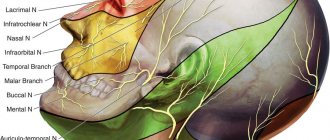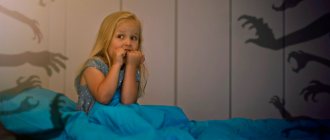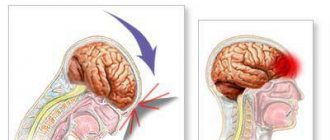Etiology and pathogenesis of narcolepsy
Scientists have not yet been able to establish the exact causes of narcolepsy. For a long time, it was believed that the etiology of the disease was closely related to mental disorders. However, this theory was not confirmed. Nowadays, a theory is being actively researched that proves that the disease occurs due to a lack of a neurotransmitter, which is responsible for maintaining wakefulness. Namely, a biologically active substance, the deficiency of which leads to narcolepsy, may be hypocretin. This deficiency may be genetically determined or occur in cases of severe fatigue, severe infection, pregnancy, or traumatic brain injury.
Another theory proves the autoimmune mechanism of pathology. Proof of this theory is that abnormal T lymphocytes are found in patients with narcolepsy. In addition, the autoimmune origin of the pathology is evidenced by the onset of its development after vaccination or the detection of infectious diseases (measles, influenza). No more is known about the pathogenesis of the pathology than about its origin. Scientists suggest that the main problem of the disease is the untimeliness of the REM sleep phase - it is introduced both during the waking period and the slow-wave sleep phase.
Causes of a special illness
Narcolepsy is a fairly rare disease (affects 1 person out of 2 thousand).
It develops mainly in 20-50 year old men, but can also appear in childhood. Despite its low prevalence, this pathology is very dangerous, because an individual can suddenly fall asleep at any moment and anywhere while performing some action. Such an attack cannot be controlled and therefore interferes with normal activities - it is impossible to properly study, work, do everyday activities, or drive a car. All this negatively affects personal and social life. Children with this disease are developmentally delayed. The sensations of those suffering from narcolepsy are similar to those experienced by people who have not slept for two days, and this reduces the quality of life.
Researchers cannot explain the exact cause of drowsiness syndrome, since it has not been studied enough due to its uniqueness. However, it turned out that psychological and psychiatric problems are not to blame.
Currently, the following factors for the development of the disease are called:
- heredity;
- lack of special genes of hypocretins (orexins) - neurotransmitters that ensure the transmission of signals to sleep and awakening in the brain;
- dysfunction of the immune system;
- overwork;
- severe infections;
- skull injuries;
- viral diseases;
- malfunctions of the endocrine glands, including the pituitary gland.
Sleepy during the day and at night, narcoleptics often have trouble falling asleep or constantly wake up. This is associated with abnormalities in the areas of the brain that regulate the main stages of sleep: the rapid phase occurs earlier than normal, and the deep phase is absent altogether.
Symptoms of Narcolepsy
The clinical picture of the disease includes four main symptoms: daytime sleepiness, cataplexy, hypnagogic hallucinations and insomnia. Typically, patients experience several of these symptoms at the same time; all four symptoms are diagnosed at once in 10% of cases.
- Daytime sleepiness
- Cataplexy
- Hypnagogic hallucinations
- Sleep paralysis
A patient with narcolepsy experiences several bouts of irresistible drowsiness throughout the day. Such attacks can be either single or multiple. The duration of attacks ranges from several minutes to a couple of hours. The patient is practically unable to resist sudden falling asleep, but he can be woken up in the same way as during normal sleep. In most cases, attacks occur in a monotonous environment, which can cause drowsiness in a healthy person (reading, watching TV).
The patient can also fall asleep in critical situations that require increased attention (while eating, talking, driving a car). After waking up, the patient often feels rested and alert, but after a couple of minutes he may fall asleep again. Night sleep in patients with narcolepsy is often fragmented and accompanied by nightmares, resulting in low productivity and performance during the day. Patients experience decreased motivation, poor concentration, and may experience depression. Patients with narcolepsy are susceptible to increased trauma.
This condition is characterized by sudden muscle weakness and paralysis caused by emotional reactions such as joy, fear, anger, surprise. Weakness can manifest itself in one limb or be generalized. In the latter case, after emotional impact, the patient suddenly collapses. Cataplexy is observed in a third of all patients with narcolepsy.
People with narcolepsy may experience unusual visual and auditory hallucinations while falling asleep. They resemble overly vivid dreams that occur during REM sleep. Most often, such illusions bother children. In adult patients, hallucinations are diagnosed extremely rarely.
A quarter of all patients with narcolepsy suffer from sleep paralysis. This is a transient muscle weakness that occurs when falling asleep or waking up. It does not allow the patient to make voluntary movements. Patients usually feel intense fear due to the inability to move.
What is narcolepsy
Narcolepsy is a pathological condition of the nervous system of a neuralgic nature. This pathology is also called Gelineau's disease. It should not be confused with psycho-emotional disorders.
Refers to hypersomnia, and is characterized by increased daytime sleepiness, which cannot be avoided.
The violation is dangerous because sleep can occur at any moment - during work, while driving a car, on the street.
Narcolepsy syndrome is a rare disease that occurs in a young percentage of the population. It most often manifests itself in people aged 15-30 years. It is very rare in women and children.
How does an attack proceed?
The essence of the pathology lies in spontaneous daytime falling asleep. There is a strong desire to fall asleep that is impossible to cope with.
Any ways to cheer yourself up become ineffective. Exercise, washing, smoking, patting yourself on the cheeks only bring you to your senses for a short time. The patient “switches off” in different places and in different positions.
A sudden dream can last either half an hour or a second.
Usually a narcoleptic person wakes up on his own and feels a surge of strength and energy.
After a short time the attack resumes again
During an important meeting, driving a car, even during an emotional conversation
This behavior occurs many times a day and can be life-threatening for the patient and those around him.
Situations are possible when a person, arriving in a state of sleep, does not stop his actions.
For example, a person sleeping while driving continues to drive the car. At the same time, nacroleptics understand that they were sleeping, but they cannot do anything.
There is another type of narcolepsy - cataplexy.
In this attack state, muscle tone is lost. The patient loses the ability to move and speak.
Often aimed at a separate muscle group, then only certain parts of the body lose activity - legs bend, arms sag, head falls. At the same time, understanding is not lost; the narcoleptic is aware of what is happening to him.
This lasts for several seconds, sometimes repeated many times, almost without interruption.
A third of patients suffering from this illness have hallucinations. They can be gustatory, auditory, visual and even tactile.
Diagnosis of narcolepsy
It is not possible to diagnose a patient with narcolepsy immediately; on average, the diagnosis is made 10 years after the onset of the disease. Patients who complain of symptoms characteristic of narcolepsy are examined by a neurologist. It must be taken into account that the disease is similar in its clinical manifestations to many other neurological pathologies. That is why, for the most accurate diagnosis, consultations with such specialists as a psychiatrist, endocrinologist, epileptologist, infectious disease specialist, and gastroenterologist may be required.
Forecast
Narcolepsy is a disease that occurs over a long period of time. Symptoms can change depending on the severity and course of the disease throughout life. Symptoms may get worse and then return to normal after a while.
In this case, drowsiness can become a permanent state, which requires the attention of a doctor and medication. Sometimes cataplexy, along with other symptoms, disappears or decreases.
Factors that may affect the symptoms observed in a patient with narcolepsy:
- regular disruption of the sleep-wake schedule;
- use of substances that affect the functioning of the central nervous system;
- infectious disease of the brain;
- various types of sleep disorders, for example, apnea syndrome.
To improve the quality of life and reduce symptoms, you need to constantly visit your doctor, follow a clear sleep schedule, and take medications prescribed by your doctor. A doctor whose specialization includes the study and treatment of such pathologies will be able to identify the symptoms of narcolepsy by conducting examinations and then prescribe treatment.
https://youtube.com/watch?v=NKKn7uI7fWQ
Differential diagnosis
It is necessary to differentiate narcolepsy first of all from epilepsy. The symptoms of the pathology are also similar to the clinical picture of other types of hypersomnia: psychophysiological, post-traumatic (provoked by a traumatic brain injury, the presence of an intracerebral hematoma), psychopathic (occurs against the background of mental disorders such as schizophrenia or hysteria), associated with inflammatory, tumor or vascular, cerebral diseases, caused by somatic pathologies (diabetes mellitus, pernicious anemia, hypothyroidism, liver failure).
How to treat narcolepsy?
Although there is currently no cure for narcolepsy, its symptoms can usually be controlled or alleviated so that sufferers experience it less frequently and can lead fairly normal lives. If you have been diagnosed with narcolepsy, your treatment plan will likely involve several components: medications, behavioral therapy, and social activities.
Over-the-counter medications containing caffeine are usually not effective for narcolepsy. However, prescription medications are available that can effectively control excessive daytime sleepiness, cataplexy, hallucinations, and sleep disturbances. You and your healthcare provider should work together to find the optimal balance between adequate symptom control and drug side effects.
Treating your narcolepsy will likely require not only medications, but also adjustments to your lifestyle. Following these recommendations can significantly improve your feelings of well-being.
Maintain a regular sleep/wake schedule. Go to bed and get up at approximately the same time every day. Regular short periods of napping during the day may be helpful. Be careful when performing activities that may be dangerous, such as driving or cooking; Try to plan your schedule so that you are alert during this time. Carefully follow your doctor's recommendations for taking medications. Tell him or her right away about any changes or problems with your medications.
It is difficult to control narcolepsy if your family, friends and colleagues do not understand the essence of the disease. Daytime sleepiness may be mistaken for laziness, depression, or loss of ability. Signs of cataplexy or dreaming while awake may be mistakenly considered a psychiatric problem.
If you have narcolepsy, your healthcare provider should talk to your family members and reassure your spouse or other family members who may feel neglected or taken advantage of that your behavior is not intentional or mentally abnormal. . Family support is an important step in coping with the disease.
Tell your employers about the disease. Providing certain conditions at work will allow you to remain a profitable employee.
Find a narcolepsy support group. Meeting other people with the same condition can be reassuring.
If narcolepsy is interfering with your job, consider other available sources of income.
If your child has narcolepsy, make sure their teachers are aware of the condition. Small adjustments in the classroom can have a huge impact on your child's self-esteem and ability to receive a good education.
Polysomnography
The disease can be diagnosed using polysomnography, which is accompanied by EEG recording and MSLT test. An in-depth and most accurate study of pathology is carried out by a somnologist in the laboratory. The polysomnography technique involves a thorough study of the patient's night sleep. To do this, you need to spend the whole night in a specially designed room under the supervision of a doctor. Using this technique, it is possible to detect a violation of the alternation of sleep phases: an increase in the duration and frequency of the REM sleep phase. The technique also allows you to eliminate similar sleep disorders.
Phase confusion
Scientists equate the sensations of a patient with narcolepsy to the state of a person deprived of sleep for two days. Despite their excruciating sleepiness, narcoleptics often cannot fall asleep properly at night.
With this disease, there are repeated attacks of sleep, which are no different from normal, but occur in an inadequate situation. If you watched the movie “Oklahoma As It Is,” then you probably remember how its hero fell anywhere due to bouts of drowsiness.
Perhaps the internal cause of narcolepsy is disintegration syndrome, the untimely onset of stages of sleep, especially fast sleep. Let us remember that sleep is divided into phases. “Slow sleep” consists of four stages, levels. The first is the most superficial, the last is the deepest. The changes that occur during each stage or during the transition from one to another can be traced on the encephalogram.
During sleep, the encephalogram shows the presence of faster waves. When we fall asleep, the pattern changes, as if calm sets in. As sleep deepens, the waves smooth out even more, and “delta sleep” begins.
After an hour and a half, dreams arise, and the encephalogram again resembles the curve of a waking person. At this time, the sleeper can observe eye movement under closed eyelids - this is the “REM sleep phase.”
Patients with narcolepsy fall asleep in less than 10 minutes - the REM sleep phase begins early in them, but the deep, delta sleep phase is completely absent. That is, they sleep superficially, and there are many night awakenings.
MSLT test
The day after the polysomnography, the doctor may prescribe an MSLT test for the patient. Namely, the patient will need to try to fall asleep five times during the day. The interval between periods of short-term sleep should be about 2-3 hours. After conducting an MSLT test, a doctor can make a diagnosis if at least two sleep episodes are confirmed. For a more accurate study of the disease, the doctor may prescribe periods of hidden drowsiness. Differential diagnosis of narcolepsy involves the following diagnostic measures: ophthalmoscopy, duplex scanning, MRI of the brain, ultrasound of cerebral vessels.
Treatment
Unfortunately, a cure for narcolepsy has not yet been found, but there are a number of medications and techniques that can to some extent control and mitigate the course of the disease. These include:
- All possible means to improve the quality of night's sleep - preparing a sleeping place, physical and emotional peace before a night's rest, avoiding caffeine-containing products, “heavy” dinners, and using relaxation techniques.
- Breaks for scheduled naps 1-2 times for 15-30 minutes.
- Use of psychostimulants.
- Use of antidepressants.
https://youtube.com/watch?v=Du40ByRGwLc
You need to understand that the treatment that narcolepsy requires must be gradual, starting with the most “harmless” methods, such as lifestyle modification, then moving on to medications. Treatment is lifelong, so patients often suffer from side effects caused by long-term use of medications.
A mandatory diagnostic program is an appointment with a neurologist, who will be able to determine the full scope of examinations and consultations, prescribe or adjust treatment.
Sleeping mode
Treatment of patients with narcolepsy should begin with normalizing their sleep and wakefulness patterns. It is strongly recommended that you go to bed and wake up at the same time. Almost all patients are shown the following sleep regimen: 7-8 hours of night sleep and two periods of daytime sleep from 15 minutes to half an hour. It is also important to take care of the quality of your sleep. To do this, you should avoid overeating, eating heavy food, and drinking alcohol in the evening.
In addition, patients should change their lifestyle: reduce the impact of stressful situations, significantly reduce the use of stimulants (coffee or nicotine), and begin to actively engage in sports. Often, people with narcolepsy experience a disruption in their biological clock, so they are active at night and feel sleepy during the day. For them, choosing a job that coincides with their natural sleep cycle would be ideal. Such a regime will allow you to get rid of the need to force your body to adhere to a standard operating mode and take stimulant drugs to eliminate drowsiness.
Patients with narcolepsy are advised to take short naps during the day. It is very important to plan your day so that you can take a 10-15 minute nap at least twice. Such sleep cannot fully replace nighttime sleep, but it will help overcome daytime sleepiness.
Diagnostics
The third edition of the International Classification of Sleep Disorders (ICSD-3) distinguishes between narcolepsy with cataplexy (type 1) and narcolepsy without cataplexy (type 2), and the fifth edition of the Diagnostic and Statistical Manual of Mental Disorders (DSM-5) uses the diagnosis narcolepsy to refer to type 1 narcolepsy only. In the DSM-5, narcolepsy without cataplexy is called hypersomnia disorder. The most recent edition of the International Classification of Diseases, ICD-11, currently defines three types of narcolepsy: narcolepsy type 1, narcolepsy type 2, and narcolepsy unspecified.
The ICSD-3 diagnostic criteria suggest that a person must experience “daily periods of an uncontrollable need to sleep or daytime lapses in sleep” for both subtypes of narcolepsy. This symptom must last for at least three months. To be diagnosed with narcolepsy type 1, a person must either have cataplexy, mean sleep latency of less than 8 minutes, and two or more sleep-onset rapid eye movement (SOREMP) periods, or have a hypocretin-1 concentration of less than 110 pg/mL. The diagnosis of narcolepsy type 2 requires an average sleep latency of less than 8 minutes, two or more SOREMPs, and a hypocretin-1 concentration of more than 110 pg/ml. Moreover, the findings of hypersomnolence and sleep delay could not be better explained by other causes.
The DSM-5 criteria for narcolepsy require that a person demonstrate repeated periods of “an irresistible need to sleep, fall asleep, or doze” at least three times a week for three months. The person must also have one of the following: cataplexy, a hypocretin-1 concentration of less than 110 pg/mL, REM sleep latency of less than 15 minutes, or a multiple sleep latency test (MSLT) showing sleep latency of less than 8 minutes. and two or more SOREMPs. To be diagnosed with hypersomnia disorder, a person must be excessively sleepy despite getting at least 7 hours of sleep, and have either occasional lapses in daytime sleep, episodes of non-restorative sleep lasting 9 hours or more, or difficulty staying awake upon awakening. In addition, hypersomnolence must occur at least three times per week for three months and must be accompanied by significant distress or worsening of the condition. It also cannot be explained by another sleep disorder, underlying psychiatric or medical conditions, or medications.
Tests
Diagnosis is relatively easy when all the symptoms of narcolepsy are present, but if sleep attacks are isolated and cataplexy is mild or absent, diagnosis is more difficult. Three tests are commonly used to diagnose narcolepsy: polysomnography (PSG), multiple sleep latency test (MSLT), and Epworth Sleepiness Scale (ESS). These tests are usually performed by a sleep specialist.
Polysomnography involves continuous recording of brain waves during sleep and a range of nerve and muscle functions during nighttime sleep. When tested, people with narcolepsy fall asleep quickly, enter REM sleep early, and may wake up frequently during the night. A polysomnogram can also help detect other possible sleep disorders that may cause daytime sleepiness.
The Epworth Sleepiness Scale is a short questionnaire administered to determine the likelihood of having a sleep disorder, including narcolepsy.
The multiple sleep delay test is performed after a person undergoes an overnight sleep study. The person is asked to sleep every 2 hours and the time required for this is recorded. Most people fall asleep within 5 to 8 minutes and also experience REM sleep more quickly than people without narcolepsy.
Measuring the level of orexin in a person's cerebrospinal fluid sampled during a spinal tap can help diagnose narcolepsy, with abnormally low levels serving as an indicator of the disease. This test may be useful when MSLT results are inconclusive or difficult to interpret.
Drug treatment
Drug treatment of patients with mild or moderate drowsiness begins with the administration of modafinil, which stimulates wakefulness. At the same time, the drug does not cause a feeling of euphoria or addiction syndrome. It is recommended to take it in the morning in an amount of 100-200 mg orally. If this amount of the drug is not enough to relieve the symptoms of the disease, then the doctor will additionally prescribe another 100 mg. In the most difficult situations, according to indications, the daily dose can be increased to 400 mg.
If narcolepsy does not respond to treatment with modafinil, then the patient is prescribed amphetamine derivatives: methylphenidate or dextroamphetamine. However, it must be remembered that these medications have serious side effects: addiction with a high risk of addiction, tachycardia, arterial hypertension. To reduce the incidence of cataplexy, patients with narcolepsy are prescribed the following drugs: serotonin reuptake inhibitors (Prozac), tricyclic antidepressants (anafranil and tofranil).
Diagnosis and treatment
Diagnosis of narcolepsy consists of a general assessment of the patient’s condition, as well as the use of polysomnography and the MSLT test. When interviewing and examining the patient, other diseases that manifest similar symptoms are excluded or confirmed. The likelihood of pathology is high if the patient experiences the following symptoms:
- attacks of drowsiness during the daytime;
- sudden weakness, falling during strong emotions;
- visions, hallucinations when falling asleep, as well as waking up;
- paralysis of the body upon awakening.
If two or more symptoms appear, you should be immediately examined and tested.
Polysomnography is a test in which small electrodes are attached to the patient's skin. They are attached using an adhesive substance. Electrodes record heart rhythm, muscle activity, intracerebral waves, and eye movements. The test results allow us to determine the characteristics of the course of the disease.
Then the MSLT test is performed, it is prescribed the day after the polysomnography. Here, electrodes are also attached to the body, but the patient must sleep. This may require several attempts at intervals of two hours. The dream lasts about twenty minutes. After these tests, the doctor makes an accurate diagnosis.
In order to eliminate drowsiness during the day, the analeptic drug Modafinil is prescribed. It is used at 100 or 200 mg in the morning. If this dosage is not enough (drowsiness occurs during the day), then an additional 100 mg is prescribed.
The second dose must be taken no later than 13:00. Additional doses of the drug are not recommended, as its use carries the risk of night sleep disturbance. Modafinil does not cause addiction.
Narcoleptics are treated with drugs called psychostimulants. Sidnocarb (20 to 50 mg per day), Meridil (up to 30 mg per day), Indopan (30 to 60 mg per day) are used.
They are prescribed in courses that should last up to one month. These medications are then gradually withdrawn (up to three weeks). To normalize good sleep at night, sleeping pills are prescribed, but in narcolepsy they have rather low effectiveness.
In order to eliminate attacks of hallucinations, as well as cataplexies, antidepressants are used. The most effective among them are: Clomipramine (25 to 150 mg) and Imipramine. They are taken once - in the morning. Antidepressants help to almost completely eliminate attacks.
In parallel with the use of medications, it is possible to use some medicinal plants to eliminate the symptoms of narcolepsy. Hops have a good relaxing effect. Its ground cones must be poured with boiling water, infused, and then strained. Drink one quarter glass before meals. The same infusions can be made from motherwort, chamomile, dill or lemon balm.
Recently, scientists have conducted many studies. At this stage, an American specialist is developing a nasal spray based on orexin. It is possible that soon, thanks to this development, narcolepsy will become a completely curable disease.
Treatment of narcolepsy involves compliance with certain rules, which are also preventive measures to prevent the occurrence of attacks. Among them are:
- Maintain a clear sleep schedule. Go to bed and get up at the same time. Try not to sleep during the day.
- Avoid nicotine and alcohol products.
- Avoid consuming caffeine and heavy foods, especially before bed.
- It is recommended to move more and play sports.
- Follow your diet.
Forecast and prevention of narcolepsy
To date, narcolepsy has no cure. As for the prognosis for the patient’s life, the disease does not affect its duration, but significantly reduces its quality. Patients who suffer from narcolepsy are prescribed symptomatic therapy. With the help of properly selected drug therapy, you can get rid of the most pronounced symptoms of the pathology. However, it is worth remembering that taking such drugs sometimes leads to side effects. There is no specific prevention of the disease, since the exact causes of its occurrence have not yet been identified.
General information
Narcolepsy is a fairly rare disease. The prevalence is 20-40 cases per 100,000 population. The disease is believed to affect both female and male genders. However, according to some reports, men still get sick more often.
The essence of the disease lies in episodic attacks of daytime falling asleep, which may be accompanied by loss of muscle tone of the entire body or individual muscle groups, hallucinations, and disturbed night sleep. Attacks of sleep during the day, one might say, take a person by surprise. Suddenly there is an irresistible desire to fall asleep that cannot be overcome. A person falls asleep in an uncomfortable position, anywhere. After sleeping for some time (which can be completely different: from several minutes to several hours), a person wakes up on his own and feels rested. However, after some time the attack repeats again. This situation can be reproduced several times a day, which, of course, significantly disrupts life.
What causes such a strange and untimely onset of sleep? Let's find out.
Not just drowsiness. How to live with narcolepsy and why there is still no cure for it
At one of my first jobs, I stood on the edge of the lions. There are some activities that are not suitable for someone with narcolepsy, and this is probably one of them. I was 22, a recent zoology graduate studying meerkats in the Kalahari Desert in South Africa. My colleague and I worked in pairs: one on the move - walking with meerkats, and the other in a jeep scanning the horizon for the danger of a lion. Many times I woke up with the imprint of a steering wheel on my forehead and the realization that I had missed out on a colleague and the meerkats. I searched the surrounding landscape for signs of life, and as the panic grew, for signs of death. Now I can tell this story only because no one was devoured.
I wasn't always like this. I slept fine for the first twenty years of my life, but shortly after my 21st birthday I began to experience symptoms of narcolepsy, a not very common (but not all that rare) disorder that affects about one in 2,500 people.
What is commonly known about narcolepsy is that the sufferer experiences frequent bouts of uncontrollable sleepiness. This is true, but the disease is much more serious: it is often accompanied by cataplexy (a condition where strong emotions cause loss of muscle tone and a person falls around like a rag doll), psychedelic dreams, sleep paralysis and frightening hallucinations.
There is no cure. Bye.
In the Kalahari in 1995, these symptoms were new to me. I didn't realize the toll the endless fight against sleep would take on my body and mind. I was not alone in my ignorance. Few family doctors have heard of this disorder, let alone seen even one patient. Some neurologists knew what to look for, but many did not. Even sleep specialists could not explain why I was suddenly experiencing this condition.
A lot has changed since then. There is growing evidence that the most common cause of narcolepsy is an autoimmune failure, in which the immune system misinterprets an upper respiratory tract infection and mistakenly clears out about 30,000 neurons in the center of the brain.
The brain is made up of 100 billion cells, and it doesn't seem like there's much to worry about.
But these are not ordinary cells, these are cells of the hypothalamus - a small, evolutionarily ancient and incredibly important device that helps regulate many of the body's basic functions, including the daily swing between sleep and wakefulness.
They are also the only cells in the brain that produce orexins (also known as hypocretins).
This pair of peptides—short chains of amino acids—was unknown to science at the time of my diagnosis in 1995. The story of their discovery, which began in the 1970s, is a wonderful tale of luck and fortune, imagination and foresight, risk and competition, and also features a colony of narcolepsy Doberman Pinschers.
There are now medications that help manage the worst symptom of narcolepsy, but none come close to correcting the brain damage behind it. The answer to my problems seems simple - I just need to put orexins (or something equivalent) in my brain. So why am I still waiting for my cure to be invented?
In 1972, a poodle puppy was born in Canada and was named Monique. When Monique tried to play, she suddenly fell over. It didn't feel like sleep, more like partial paralysis. Veterinarians suspected narcolepsy with symptoms of cataplexy. Monique was transported to California, where she was studied by sleep specialist and Stanford University professor William Dement. Word began to spread, and soon Dement and his colleague Merrill Mitler were watching not only Monique, but several other dogs as well.
The fact that narcolepsy was more common in specific dog breeds suggested that the disorder had a genetic basis.
Then came the breakthrough: Dement was informed of a Dobermann litter of seven puppies, all with narcolepsy and cataplexy. “During the first 24 hours, each of the puppies collapsed to the ground once,” says Mitler.
It turned out that in Labradors and Dobermans the disease was inherited. Dement decided to focus on Dobermans, and by the late 70s he was already the proud owner of an entire colony of dogs of this breed. He found that narcolepsy in Doberman Pinschers is caused by the transmission of a single recessive gene. By the 1980s, genetic analysis techniques had advanced enough to try to track down the defective Doberman gene.
I will never be able to reconstruct the combination of factors that led to the manifestation of my narcolepsy, but the main thing happened at the moment of my conception in 1972 - around the same time Monique was born in the Canadian province of Saskatchewan. I have inherited a special version of a gene (known as HLA-DQB1*0602) that is involved in a process that helps the immune system distinguish friend from foe.
The HLA-DQB1*0602 gene is quite common—about one in four Europeans have a copy—and it plays a key role in many cases of narcolepsy, present in about 98% of people with narcolepsy and cataplexy.
In addition to genetics, time also appears to play a role. People with narcolepsy are often born in March (like me). This “birth effect” is seen in other autoimmune disorders and is likely explained by seasonal infections. In the case of narcolepsy, it seems that those born in March are simply a little more vulnerable than everyone else.
Although other childhood infections, hormonal imbalances, and stress could also have contributed, I encountered a key pathogenic factor in late 1993 - an influenza virus or, possibly, a streptococcal infection. This was an autoimmune tipping point that resulted in the rapid destruction of my orexin system. In short, most cases of narcolepsy are the result of an unfortunate set of circumstances that created the ninth immunological wave, the perfect storm.
Around this time, the Dobermann Project at Stanford was getting closer to solving the mystery of narcolepsy in the breed. The mutation was tracked by Emmanuel Mignot, who later succeeded Dement as director of the Stanford Sleep Research Center. We meet in his office, accompanied by Mignota's narcolepsy Chihuahua, Watson. “Such a stupid breed,” he says. “I would never choose such a dog for myself.”
At first, Watson is wary of me and keeps his distance. I sink to the floor, he yelps and jumps on me, pretending to be angrier than he is.
I feel empathy, although his appearance is separated from mine by an abyss. I know what it's like to be very sleepy during the day. I know what cataplexy is, I know what it’s like when emotions short-circuit the neurological network in the brainstem and cause muscle collapse (this happens in REM sleep, which is when we dream most often).
I wonder if Watson is afraid of sleep paralysis and the supernatural hallucinations that often accompany sleep paralysis. The dog's eyelids close and then open again, and I recognize the lethargy in his gaze. He climbs into a basket and curls up to sleep throughout the interview.
In the 1980s, the idea of finding the gene responsible for canine narcolepsy seemed prohibitively ambitious. Breeding narcoleptic Dobermans is a more difficult task than it seems at first glance, since such dogs can collapse in the middle of sexual intercourse, temporarily paralyzed by cataplectic tremors (so-called orgasmolepsy, which also happens in humans). And even without taking into account this inconvenience, it was necessary to find a gene whose sequence is unknown in a genome that was not studied at that time. “Most people said I was crazy,” Mignot recalls. In a sense, they were right: it took him more than ten years, hundreds of dogs and more than a million dollars. And they almost got ahead of him.
In January 1998, as Mignot's team was nearing the finish line, a young neuroscientist, Luis de Lecea of the Scripps Institute for Research in San Diego, published a paper describing two new brain peptides. De Lecea and his colleagues called them hypocretins, from the word hypothalamus, where they were found, and from the word secretin, a hormone with a similar structure. These were chemical transmitters that functioned exclusively within the brain.
A few weeks later, a team of scientists led by Masashi Yanagisawa from the University of Texas, independently of de Lecea and his colleagues, described the same peptides, but called them orexins and also presented the structure of their receptors. They hypothesized that the interaction of these proteins with receptors may influence appetite regulation. “We didn’t think about sleep at all,” admits Yanagisawa.
At Stanford, Mignot learned of the publication of two papers, but there was no reason to believe that the discovery had anything to do with narcolepsy or sleep. However, by the spring of 1999, he and his team figured out that the recessive mutation must lie in one of two genes. One is expressed in the foreskin. “It didn’t look like a candidate for narcolepsy,” Mignot says. There remained a second gene, which encoded one of the two orexin receptors. When he learned that Yanagisawa's team had created a mouse without orexins, and that mouse was now exhibiting symptoms of narcolepsy, the race was on.
A few weeks later, Mignot and his colleagues published their work in the journal Cell, where they described a defect in the gene encoding one of the orexin receptors. “This result suggests that hypocretins (orexins) are important sleep-influencing neurotransmitters, which opens the prospect of new approaches to treating patients with narcolepsy,” they wrote. Kahlua, one of a litter of Dobermans named after the liquor, lies lounging on the cover of the publication. Yanagisawa and his colleagues published the results of their experiments two weeks later, also in the journal Cell.
Under normal circumstances, a chemical transmitter and its receptor act like a key and a lock. The key (transmitter) fits into the lock (receptor) to open the door (cause a change in the target cell). In the case of Mignot Dobermans, a massive mutation messed up the orexin receptor lock, rendering orexin useless.
Either the lock does not work, as in this case, or there are no keys, as in the case of Yanagisawa's mice, but the outcome is the same - the door will not open. The orexin system has gone haywire. In the case of humans, there are many ways to break the orexin system. Sometimes the damage is caused by a brain tumor or head injury. In most cases, however, narcolepsy is caused by an unfortunate combination of circumstances, as described above.
Orexin neurons are a very important thing, and not just for those who have lost them. They are present in almost all major classes of vertebrates and serve a very important function. When de Lecea first described orexins in 1998, he was not yet thirty and had just arrived from Barcelona to San Diego. In 2006, he moved to Stanford to be closer to sleep science. “To be honest, I thought we would understand the system much better by now than we ended up understanding it,” he says.
However, much has been learned, especially thanks to optogenetics. By introducing a virus, a promoter and a gene from blue-green algae, it is possible to identify a specific group of light-sensitive neurons.
To illustrate this magic, de Lecea shows a video on his laptop. In the video, we see a mouse that has been genetically programmed to fire orexin neurons in response to light. A thin fiber optic wire is connected to the mouse's brain. “The mouse is sleeping,” he says, and at the top of the screen we see waves of electrical activity characteristic of deep sleep. The wire comes to life, a bluish flash lasting ten seconds. Light-sensitive orexin neurons release neuropeptides and suddenly the rodent wakes up. When the light turns off, the mouse falls asleep as quickly as it woke up.
Suddenly my tear ducts tingle, and for a split second I almost envy this mouse.
Using optogenetics and other techniques, de Lecea was able to show that orexins play important roles in many neurological networks. They sometimes function as neurotransmitters and help neurons release norepinephrine into the cerebral cortex. In other cases, orexins act more like hormones. This is how orexins influence other chemicals in the brain, including dopamine (plays a key role in the reward system, planning and motivation), serotonin (strongly associated with mood and involved in depression) and histamine (an important warning signal).
“Most other neural networks have parallel and multiple layers of security,” says de Lecea. “So if something goes wrong, other systems step in and take over. In the case of orexins, however, there is little or no safety net.
That is, manipulating this system produces a clear response that scientists can work with. It's a great model for understanding how neural networks work more generally."
What we now know about orexins also helps explain why the loss of just a few tens of thousands of cells can lead to a serious, multi-symptom disease like narcolepsy, which disrupts wakefulness and sleep, body temperature, metabolism, appetite, motivation and mood. These proteins give us an extraordinary insight into how the human brain works.
And this makes the orexin story an archetypal double helix tale, and a great illustration of how science works. There's a mystery (narcolepsy), a primordial story (Monique), a vision (Dement), aspiration (Mignot), a technological discovery (genetics), a photogenic animal (Dobermans), a competition (with Yanagisawa), looks like science (optogenetics) and yet has high goal (sleep and brain).
It's elements like these that can turn modern scientific events into compelling cultural narratives, says Stephen Kasper, a historian of neuroscience at Clarkson University in New York. “Here are all the ingredients for what physiologists and neurologists at the beginning of the 20th century were looking for and hoping to find - something that would unite heredity, biochemistry, biophysics, neurology and psychology.”
“However, a tendency in biochemical studies of niche disorders is that they often show promise, but never help the patients themselves,” adds Kasper. Something is missing from the narrative around narcolepsy, he says: “A good story should have a clear happy ending.”
We're still waiting for that happy ending.
Even if I could get a bottle of Orexin A and Orexin B, how would I get them into my brain? If I swallowed them in solution, the enzymes in my intestines would make short work of them, plucking the amino acids like beads from a necklace. If injected into a muscle or blood vessel, few will penetrate the blood-brain barrier.
There have been experiments with nasal delivery, suggesting that inhaling orexins could be a way to smuggle some of them into the hypothalamus through the olfactory nerve, but no one has made a big investment in this approach.
This does not mean that the pharmaceutical industry ignored the discovery of orexins. Not at all. 15 years after Mignot's publication, Merck received approval from the US Food and Drug Administration to market the drug suvorexant (commercial name Belsomra). The substance passes the blood-brain barrier and blocks orexin receptors. And it is a sleeping pill.
Sleeping pills weren't exactly what people with narcolepsy needed. By preventing orexins from binding to receptors, the drug provides a completely narcoleptic high - but the fog from it dissipates the next morning. Sleeping pills, commonly used to treat insomnia, depress the nervous system as a whole, says Paul Coleman, a chemist at Merck Laboratories in Philadelphia. “Suvorexant is different in that it very selectively blocks wakefulness without affecting the systems that control balance, memory and thought,” he says.
Coleman developed drugs to treat a number of different infections, diseases and disorders, but the orexin system stands out. “Narcolepsy has given us a thread that we can pull and unravel the tangle of knowledge about what lies behind the system that controls sleep and wakefulness,” says the chemist. — Staying awake is a fairly key process for all of us, whether you are healthy or have insomnia or narcolepsy. This is the most fun thing I've ever worked on."
The use of suvorexant could be expanded, and clinical studies are planned on its ability to provide quality sleep to shift workers, improve sleep in Alzheimer's patients, help those suffering from post-traumatic stress disorder and drug addiction, and alleviate the symptoms of panic disorder.
I'm glad to see news like this, but we millions of people with narcolepsy are still waiting for a drug that will shake up, rather than tame, the orexin system.
Masashi Yanagisawa, who 20 years ago competed with Mignot to link orexins to narcolepsy, has been working on this for a long time. But designing and synthesizing a substance that will pass through the gut intact—that's what it takes to get it from the blood to the brain—and that has the perfect configuration to activate one or both orexin receptors—"that's a very, very big challenge," he says. This is “significantly” more difficult than finding a compound that inhibits the receptor, as suvorexant does.
Earlier this year, Yanagisawa and his colleagues published data on the most potent such compound to date, the small molecule YNT-185. Injecting this molecule into narcoleptic mice significantly improves their wakefulness and reduces excess REM sleep (one of the characteristics of narcolepsy). Although YNT-185's affinity (how strongly it binds to the orexin receptor) is not sufficient to warrant clinical trials, Yanagisawa's team has already identified a number of other potential candidates. “The best one is almost a thousand times stronger than YNT-185,” he boasts. Although the symptoms of narcolepsy can vary widely from person to person, the underlying pathology—the absence of orexins—remains the same. “If this compound works, it will work for all patients. In this sense, it will be a relatively simple clinical trial compared to many other disorders,” says Yanagisawa.
An even more futuristic prospect involves the use of stem cells.
Sergiu Pasca shares the office next door to Emmanuel Mignot at Stanford, and in 2015 he and his colleagues developed a way to take induced pluripotent stem cells made from skin cells and direct them to new lives as brain cells.
In theory, it is possible to grow an orexin neuron and transplant it into the brains of people with narcolepsy. However, everything is not so simple. Firstly, it is unlikely that the cells themselves will be exactly the same as orexin cells, secondly, inserting a needle into the brain is a risk, and thirdly, there is always the possibility that the immune system will make another attack - this time on the transplanted cells.
So, will the tale of orexins have a happy ending? Translating basic research to the clinic is difficult and expensive, Kasper notes.
The cost of the most affordable drug for narcolepsy - sodium hydroxybutyrate - is such that not every patient can afford it, although the drug is one of those that can qualitatively change the lives of many people.
It is widely believed that narcolepsy is a rare disorder with a small market, so any pharmaceutical research and development in this area is unlikely to generate significant revenue. This view ignores the fact that many people are likely undiagnosed with narcolepsy, and that a person who develops narcolepsy as a teenager and lives to age 80 will require approximately 25,000 doses of the drug over the course of his or her lifetime.
The orexin-stimulating drug may also be useful for any condition characterized by excessive daytime sleepiness, not to mention the myriad of other situations where low orexin levels play a role, including obesity, depression, post-traumatic stress disorder and dementia.
I believe there is another reason that this story has not yet come to an end.
For too long, we have undervalued sleep, seeing it as an inconvenient distraction from wakefulness. In this way of thinking, sleep research does not seem to be a priority. But this is far from a rational approach.
We now have ample evidence to show that poor sleep can have devastating effects on your physical, mental and mental health. Sleep is not something secondary. Sleep is key, it is a matter of health for entire nations. Investing in sleep research isn't about tackling a few obvious sleep disorders. This is about all of us.
How to detect the disease and which doctor to go to
First, you should do an analysis of the complaints with which you go to the doctor. They can be of the following nature:
- Duration of the disease: when it appeared, and what signs were the first.
- Heredity: did anyone in the family suffer from a similar illness.
- The presence of severe traumatic brain injuries, severe infectious diseases.
- Medicines you are using.
- The presence of allergic reactions to any drugs or products.
A neurologist examines patients with signs of narcolepsy.
To detect this pathology, polysomnography is performed with recording of an electroencephalogram and a multiple sleep latency test.
For a more accurate sleep analysis using specialized somnological laboratory procedures, you need to undergo an examination by a somnologist.
You should also undergo computed tomography and magnetic resonance imaging. This will allow us to study the structure of the brain more deeply and eliminate the possibility of damage to the areas of the brain responsible for sleep and wakefulness.
Strange story
Of course, not all sleepiness is narcolepsy. There are times in any person's life when the need for sleep increases. Here, for example, is the story that happened to the author of these lines in his youth.
After two unsuccessful attempts to become a student and service in the army, I entered the university. The day before I had an affair with one girl, we were going to get married, but then we broke up. I was very painfully experiencing the breakup and then, while studying in my first year, I suddenly felt a strange state...
I was attacked by a stupefying drowsiness, I could not stay awake for more than thirty to forty minutes, a maximum of an hour, then I inevitably fell asleep. Moreover, it came at the most inopportune time, in the most inopportune place: on the subway, at a lecture. To prevent this from happening, I decided to get enough sleep: during recess I would find an empty classroom and, sitting down on three pushed-together chairs, instantly fell asleep. Luckily, I only needed 5-10 minutes to fall asleep. Then I got up, invigorated, and could exist normally for about another hour. Then something like dizziness began again and it was necessary to urgently take a horizontal position. This state lasted two or three days and passed.
Ten years later, these attacks of drowsiness were repeated after another stress - the death of my father. On weekends I slept around the clock. I fell asleep on the train and in the subway. So, maybe this is narcolepsy?
At the Center for Somnological Research of the Ministry of Health and Social Development of the Russian Federation, Professor Yakov Iosifovich Levin explained to me that attacks of drowsiness recurring once every ten years are unlikely to be a disease. Normal stress from prolonged overexertion manifests itself differently in different people. Some cannot fall asleep, others, on the contrary, sleep like marmots, and this helps them recover and come to their senses. In patients with narcolepsy, attacks are much more severe and occur more often.









